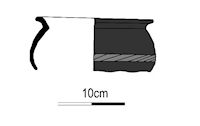
The Oakridge Well in Hampshire also produced a Type 18 vessel (Figure 13). This example was described as 'possible', rather than 'definite' in the earlier catalogue because the author had not handled it (Gerrard 2004). On reflection this vessel is almost certainly a definite example as it is explicitly described as being BB1 in the excavation report (Oliver 1992, 86).
The well was a substantial feature some 26.5m deep. A progression of fills contained a variety of pottery (including complete vessels), animal and human bones, some of which seem to have been articulated. The filling of this well appears to indicate that it had crossed a line and become a 'ritual shaft'. At depth of just over 20m a copper-alloy buckle was found with a round frame and oval plate with three rivets (Oliver 1992, fig. 8.1). This appears to be a buckle of Somer's Sorte I, Form A, Type A. This is considered to be a 4th-century type but they are present in graves dated AD 388-402 and to the end of the 4th century at Lankhills and have been found elsewhere with very late 4th-century pottery (Cool 2010, 285-6). Stratified above this buckle were a coin of AD 364-378 (the only coin from the well), the Type 18 bowl (Oliver 1992, fig. 12.80) and two OXRS vessels of Young's (1977) Types C46 and C84 (AD 340-400+ and AD 350-400+) (Oliver 1992, 85-86). A late 4th- or early 5th-century context appears probable for this Type 18 bowl.
